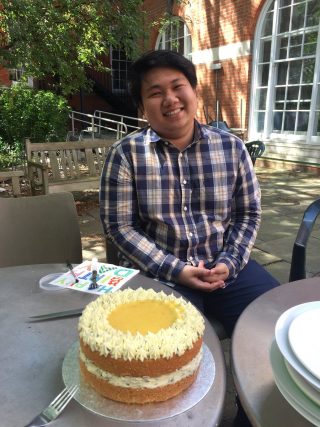Chatrin Suksasilp - What I learnt from my Wellcome Trust Biomedical Vacation Scholarship
This summer, I joined the Literacy, Language, and Communication (LiLAC) Lab, supervised by Prof Courtenay Norbury. My project, titled ‘Influence of language on emotion regulation in adolescence: links with mental health’, was funded by a Wellcome Trust Biomedical Vacation Scholarship, which aims to give undergraduate students hands-on experience of conducting research.
We focused on emotion regulation, or the ability to monitor and change emotional reactions to thoughts and events. The strategies that people use to manage their emotions often require verbal skills or ‘self-talk’, though research has rarely investigated whether being skilled at emotion regulation depends on having an adequate level of language proficiency.
Answering this question is an important step in cracking the puzzle of mental health in children and adolescents. A whopping 75% percent of mental health problems in the UK start before the age of 18 [1], and children with developmental language disorder are at double the risk of developing mental health problems compared to their peers [2]. The link between language and mental wellbeing might be adolescents’ skill for managing their emotions using cognitive strategies, which my project investigated.
My first task was to throw myself into the deep end of emotion science. How do negative emotions arise and what strategies do we use to manage them? How useful are these strategies for supporting mental wellbeing? Do they in some way depend on language?
I trawled the experimental literature to understand what we know so far about these questions, and how the focus of my project fits in with what we already know. Our experiment focused on a specific technique for managing stress and negative emotions, called temporal distancing, which is all about thinking that even though you’re upset or stressed about something that happened today, by tomorrow you’ll get over it; or, by next week you’ll have forgotten about it; or, in a few years’ time it won’t have mattered at all in the grand scheme of things. We’ve all done something like this to cope with stressful events in life, and it has been shown to longitudinally support mental wellbeing in adults [3]. Adolescents with typical language can also use temporal distancing effectively [4]. However, we don’t know whether or not children with language difficulties are able to use the same technique to manage their emotions.
The next and most difficult part of my project was taking our area of interest – using temporal distancing to manage emotions – and dissecting it into specific research questions for which we had hypotheses that were testable using the tools available to us. Did we expect individuals with better language skills to also be better at managing their emotional reactions? Did we expect to see this relationship in both 10-year-olds and 20-year-olds? How best should we measure language? How reliable is our experimental method for assessing ‘skill’ at temporal distancing? I had to figure out the answers to many such questions to produce a precise explanation of the methods we were going to use.
Only then could I prepare the experiment that we would use to assess participants online. This involved an awful lot of head scratching to figure out how to implement our language measure online, how to code automated scoring into it, and how to keep track of which participant was which over the one-week experiment period. After that came the test runs and double-checking, then triple-checking, that it all worked. The bright side of all this was that, once we were sure that it did work, we could just press ‘launch’ to start recruiting participants online and relax as the data flooded in.
I also got a taste of doing all the other jobs that come with running a research study like writing ethics and copyright requests, not to mention helping the SCALES team pack envelopes to be sent to 400-odd parents. Not that it was all hard work, of course – Courtenay made sure that we had time for tea and cake every now and then!
Back on topic: the reason we planned ahead so meticulously (in addition to simply good practice) was that a key objective for my project was to submit a pre-registration of my study to the Open Science Framework. A pre-registration is a record of what our research questions were and what experimental and analytical methods we were going to use, that sets these out in stone before we collected any data. This is best practice in support of Open Science, a recent wide-spread initiative to make psychology and science as a whole more reproducible, transparent, and reliable.
Writing a pre-registration made me learn Open Science practices from the outset of my research career. In fact, everything else I have done to make this experiment happen has been training me in the skills required to conduct independent research, and all of it has been an incredibly valuable learning experience. Working in the LiLAC Lab, I got the chance to speak with PhD students and postdoctoral researchers, as well as learn from them in lab seminars, which gave me a glimpse of what the early years of academia are like – and so far, it looks like something I’d really love doing! We’re now in the process of writing up this study to submit to journals, which is also mind-blowing to have on an undergraduate CV.
On top of that, I’ve gone from knowing nothing about emotion science to discovering a new passion for it! I am now extending my interest by writing coursework on the role of memory in emotion, and how we are constantly forgetting negative episodic memories to support emotional wellbeing and mental health – which is something I am very interested in pursuing further in postgraduate study.
Acknowledgements:
I am indebted to many people who have helped me complete this project: Courtenay and Sarah for guiding me through every stage of the project, and for patiently reading and commenting on my many, many, drafts (with still more to come!). Gwen Brekelmans for kindly agreeing to help us record the language assessment stimuli and soldiering through technical failure (and Sarah again for being the voice of the vocab test!). Shaun Goh for his advice on life and statistics, and for being someone I could go get a sandwich with. Jess for the phenomenal birthday cake (pictured below), and Laura for being an awesome mentor on my first school testing outing!
References
[1] Murphy, M., & Fonagy, P. (2012). Mental health problems in children and young people. Annual report of the chief medical officer, 1-13.
[2] Yew, S. G. K., & O’Kearney, R. (2013). Emotional and behavioural outcomes later in childhood and adolescence for children with specific language impairments: meta‐analyses of controlled prospective studies. Journal of Child Psychology and Psychiatry, 54(5), 516-524.
[3] Bruehlman-Senecal, E., Ayduk, Ö., & John, O. P. (2016). Taking the long view: Implications of individual differences in temporal distancing for affect, stress reactivity, and well-being. Journal of personality and social psychology, 111(4), 610.
[4] Ahmed, S., Somerville, L., & Sebastian, C. (2018). Using temporal distancing to regulate emotion in adolescence: modulation by reactive aggression. Cognition and Emotion, 32(4), 812–826.
